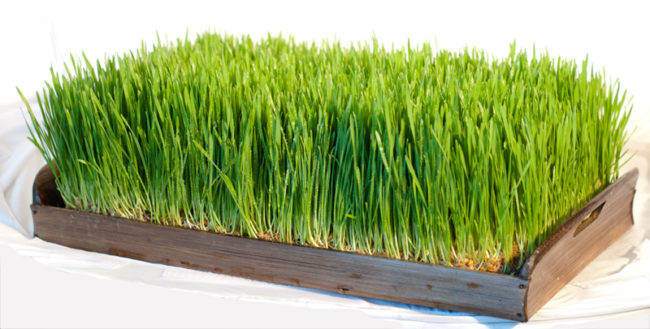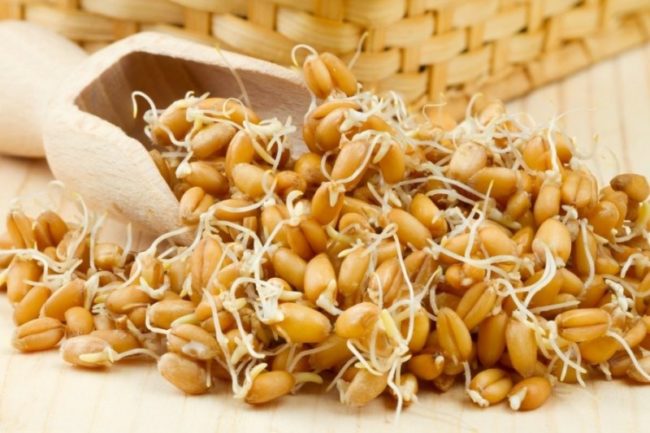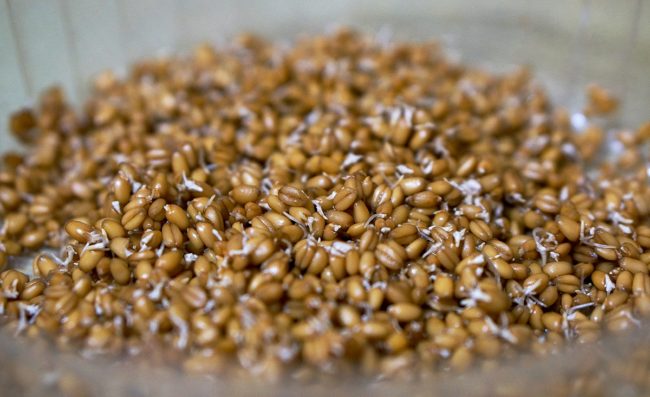In recent years, a healthy lifestyle has become a real trend. And such a product as a sprouted wheat is considered one of the most important components in the diet of a person who is fond of healthy nutrition. You can buy wheat sprouts in finished form, but it is cheaper to engage in their germination yourself, especially since there is no difficulty in this. How to grow wheat at home, we will tell in this article.
Content
- How to grow wheat. What you need to start
- How to grow wheat. Choose grains for wheat germination
- How to grow wheat
- How to grow wheat. Useful recommendations
- Than the germinated wheat is useful
- How to grow wheat. Contraindications to the use of wheat sprouts
- How to use sprouted wheat
- How to grow wheat at home. Video
How to grow wheat. What you need to start
Before growing wheat at home, you need to prepare everything you need for such a process. So, this is what you need:
- Wheat grains. They should be high -quality and unprocessed by any chemicals. The grains of winter culture are best suited for germination.
- Run for germination. It should be plastic or glass, but not metal. If you choose a plastic tray, check that it is made of food raw materials. Is it possible to grow wheat in something else except the tray? You can, for such a purpose, simple glass jars are suitable. Banks when germinating are best covered with gauze.
- Air humidifier - you will need if you decide to seriously engage in wheat germination at home and are going to do it constantly. For household purposes, some inexpensive model is suitable.
- Fresh clean water at room temperature.

How to grow wheat. Choose grains for wheat germination
Before growing wheat sprouts, you need to choose the raw material itself. Here we would like to give you some tips:
- In stores or in the departments of a healthy diet, you can find wheat specially designed for germination. It has an appropriate marking, and you can be sure that, subject to all the rules, you will get a qualitative result. However, if you want to save, wheat can be bought from farmers when there is such an opportunity.
- It is very desirable that the raw materials are not treated with any chemicals. Unfortunately, it is simply impossible to check this with the naked eye. If you buy special environmentally friendly grains, you can be calm - they probably meet all the stated requirements. It will not be possible to check the wheat purchased in the market. But you can evaluate at least its appearance. So, pay attention to the size and integrity of the grains. If possible, they should be the same, not chopped, not wrinkled, dry, smooth, without mold. If the appearance is alarming you, immediately wonder: is it possible to grow such wheat, and will there be any benefit from it? Choose only the product that does not cause you suspicion and looks healthy and high -quality.
- It so happens that even beautiful grains do not sprout and begin to reth even when they swell in water. If you notice mold, do not germinate such wheat, but just throw it away.
- Different varieties of culture in different ways swell and germinate. They may also require different temperature or humidity. But there is one rule that should be observed when germinating wheat at home: grain in water is better not to be overturned than overexposed.

How to grow wheat
- Having chosen and bought wheat grains, the first thing they should be soaked in water. Moreover, it is important to first measure the right amount of raw materials. For a large tray or tray of 40x40 cm in size, it will need approximately a couple of glasses. There should be so many grains so that they cover the bottom with a thin layer.
- Having measured the seeds, pour them into a colander or sieve and rinse with clean cool water. Then put them in a bowl and soak them. It is necessary to soak wheat in a clean, if possible, filtered water temperature water. Its volume should be 3 times larger than the volume of seeds.
- Pour grain, cover them with a film or lid and leave on the table for 10 hours. After this time, drain the water and dial the fresh, slightly cooler than the previous, and also filtered. Its amount of it should also be 3 times higher than the number of seeds. Leave the wheat again for 10 hours. Then, for the third time, do the same procedure.
- The result of such soaking should be the appearance on the seeds of small roots.
- Rinse wheat and prepare a tray for it. If there are holes in the bottom of the tray, lay paper towels to the bottom - so the roots will not germinate through the container. Then take an organic compost or soil and pour it with a layer of 5 cm. Please note that you need to grow wheat at home without fertilizers, otherwise it can only be harmful instead of good. By the way, paper towels that you laid in the tray should also be clean, without paint and fragrances. You can grow wheat without earth. To do this, take a tray without holes and a cut of gauze. Gauze, folded in several layers, must be laid on the bottom, distribute the seeds on top and cover with several layers of gauze.
- Pour the grains on the prepared compost and distribute in an even layer. Then press slightly to the ground, but do not dig the whole.
- Pour wheat with clean water, trying to moisten all areas. If you grow grains on the gauze, it also needs to be carefully moistened, but not to fill it completely so that mold does not appear.
- Then cover the tray with seeds with wet newspapers or fabric.
- Every day check wheat and make sure that it does not dry out. Irrigate compost regularly for several days. Again, do not fill the tray with water in excess of measure. The newspapers lying from above also spray from the sprayer.
- After 4 days, remove the newspapers and water the sprouts once a day.
- The question of where to grow wheat is also important. It is better to do this in a place where the straight rays of the sun do not fall, but not too dark. There should be warm and scattered light should be present.

How to grow wheat. Useful recommendations
To know how to properly grow wheat at home, you should listen to some tips:
- Where you place the tray with wheat, the air temperature should be 22-24 ° C. In such a place you need to maintain high humidity, and if the air in the room is too dry, it is better to use a moisturizer.
- You can not pour too much water into the container. In such conditions, the seeds will not germinate, but only burst and mold.
- If you do not maintain constant humidity, wheat, on the contrary, will dry and does not germinate. Therefore, it is necessary to regularly moisten the soil, and newspapers or gauze that lie on top.
- It is also not necessary to pour the grains with a too thick layer, because the lower seeds will simply suffocate, and there will be no benefit from them.
- As a rule, subject to technology, high -quality raw materials germinate per day. Moreover, almost all seeds should germinate. You need to eat wheat for food immediately, and its sprouts should not become longer than 3 mm - in this case they will be very harmful to the body. Those grains that are not sprouted, it is advisable to throw away, since they can be affected by some kind of disease.
- If the wheat has not sprouted within 2 days, it just needs to be thrown away, because either the raw materials turned out to be poor quality, or you made some mistakes when germinating.

Than the germinated wheat is useful
Wheat itself, even in an unnecessary form, is a rich source of useful components. In dry grains, such components are in an inactive phase, but at a time when a sprout is cursed from the seed, the grain tries to give it everything that is needed for active development. Thus, wheat seed mobilizes all the beneficial substances that are hidden in it.
Propheted wheat is useful not only in its contents, but also by the fact that the contents are balanced, it is absorbed by the body almost completely. That is why cultural sprouts are considered a valuable biologically active food supplement, which, moreover, has absolutely natural origin.
If we talk about the composition of the sprouted wheat, then it contains the following components:
- fatty acids;
- maltose;
- dietary fiber;
- 20 different amino acids;
- minerals;
- vitamins: C, E, PP, B vitamins V.
The highest concentration of these substances is present in the product when its sprouts reach 1-2 mm in length. It is believed that sprouted wheat contains components that are involved in the construction of nucleic acids, and those, in turn, are the basis of our genes. This leads to the fact that in the human body, after consuming the product, reserves appear to restore and treat many, including serious diseases.
If we talk about what effect the sprouted wheat on the body has, then the following must be distinguished:
- The product establishes the work of many organs and body systems. Tones the body, increases immunity and allows a person to easily cope with infections. Wheat normalizes metabolism, gives vigor and energy.
- It is especially useful to use it after diseases, when the body is depleted and does not have enough strength to restore. For people with reduced immunity, this product is also important in the diet. You can use sprouts as a prophylactic, for example, in the SARS season and with influenza epidemics.
- Such food also acts on the work of the nervous system, eliminating depression and stress.
- Propheted wheat is useful for men. It is believed that its prolonged use helps to cope with sexual dysfunction.
- Magnesium, which is found in cultural sprouts, perfectly reduces blood pressure, and also removes cholesterol from the blood.
- Insoluble fibers of fiber are useful for the work of the gastrointestinal tract. Propheted wheat helps to fight constipation, removes toxins, toxins and radionuclides. Soluble fibers also have a beneficial effect on the digestive tract, absorbing bile acids and establishing the intestinal microflora.
- Normalization of metabolism, which contributes to the use of sprouted wheat, helps with obesity. The product itself is very small -calorie, but it saturates well, quickly and for a long time relieves hunger. Those who suffer from excess weight and decided to eat sprouted wheat, it is advisable to exclude bread from the diet.
- Wheat sprouts are considered an excellent means of preventing cancer. In some cases, such a product helped to cope with existing neoplasms: cysts, myomas, fibromas, polyps.
- Propheted grains are recommended to be consumed with visual impairment, the presence of various inflammations in the body, diabetes mellitus. Wheat sprouts help restore even very poor vision, if there are regular and for a long time. As for diabetes, such food greatly facilitates the course of the disease and has a beneficial effect on the thyroid gland.
- Propheted wheat has an anti -aging effect on the body, improves the complexion, skin condition, hair, nails and teeth. It charges the body with energy, gives strength and activity.

How to grow wheat. Contraindications to the use of wheat sprouts
Despite all the naturalness and benefits of wheat, it has a number of contraindications:
- It should not be eaten by those who have kidney problems or serious disorders in the work of the gastrointestinal tract.
- Those who are prone to frequent intestinal disorders should also be inherent in such a product in their diet.
- In the sprouted wheat, as in any other, there is gluten. For most people, he does not represent anything bad, but there are those who do not tolerate such a component.
The reaction to the use of sprouted wheat can be a digestive disorder, but, as a rule, after some time the body gets used to it and this symptom disappears on its own.

How to use sprouted wheat
Wheat
Wheat for the preparation of juice is germinated for a long time until the sprouts are reached in a length of 10-12 cm. Then they can be cut and squeezed out. For this, they do as follows:
- First, the sprouts are washed with cool water
- Then put in a special juicer intended specifically for such purposes. A simple juicer in this case will not get part, because the blades of grass can score it, and it will fail. Special devices for the preparation of juice from wheat sprouts are made so that you can get the maximum amount of liquid.
- If you do not have such juicers, then grind the stems with a blender, and then strain through a very small sieve or gauze.

Plum-global breakfast with wheat sprouts
Such a dish is very useful for breakfast, and it is prepared from the following components:
- prunes - 8 pcs.;
- apple - 1 pc.;
- water - 1 cup;
- propheted wheat - 1 tbsp.
Mashed potatoes are done in this way:
- The prunes are poured with a glass of water, left overnight.
- The next morning, water is poured into a bowl, rub an apple on a fine grater, mixed with water.
- The prunes are crushed in a blender and also added in mashed potatoes. They put wheat sprouts there, mix.

Wheat
A salad with wheat sprouts is prepared from these products:
- kiwi - 1 pc.;
- grenade grains - 3 tbsp;
- banana - 1 pc.;
- brynza - 100 g;
- sunflower seeds - 3 tbsp;
- propheted wheat - 2 tbsp;
- honey is to taste.
Grind the sunflower seeds and sprouted wheat, mix with honey, crushed with an eyebrow and fruit cut into pieces. Sprinkle everything with grenade grains on top.

Puree from apples and wheat sprouts for weight loss
Those who want to lose weight, such puree are recommended to be consumed instead of breakfast. To prepare it, clean 2 large apples and grind in a blender until a homogeneous state. Then mix with 2 tbsp. wheat sprouts and eat. The next meal should be no earlier than after 4 hours.
You can eat sprouted wheat with honey. For this, approximately 3 tbsp. The product must be twisted in a meat grinder and add 2 tsp. honey. It is not necessary to drink this tool, but after it you can only after 3 hours.










Comments
a couple of years ago, there was no side of metrogils from the same problem, there were no side effects ...
I’m not a fan of peeling at all, it saves from acne of metrogil, it also smoothes it ...
Great article! ...
I take the second course of the Capsules Climafite 911. The tides went very quickly. It became calmer, irritability went away and I sleep well ...
i also noticed - it is worth nervous, everything immediately affects the face. Therefore, I try to avoid conflicts and unpleasant people. Of the creams, I like Miaflow from wrinkles - smoothes not only small wrinkles ...